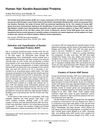TLDR Trichothiodystrophy causes abnormal protein deposits and distortion in hair follicles.
The study conducted detailed ultrastructural and electron histochemical analyses on the hair shaft and anagen hair follicle in trichothiodystrophy, revealing reduced and disoriented protein deposition in the follicle, along with overall distortion in anagen follicles. Both the hair cuticle and cortex high sulfur protein components were affected. These findings provided a visual interpretation that complemented biochemical studies by other researchers, enabling specific localization of the intrinsic keratin abnormality.
50 citations
,
July 2008 in “British Journal of Dermatology” 138 citations
,
March 2007 in “Experimental cell research” Only a few hair-specific keratins are linked to inherited hair disorders.
 71 citations
,
August 2005 in “The journal of investigative dermatology. Symposium proceedings/The Journal of investigative dermatology symposium proceedings”
71 citations
,
August 2005 in “The journal of investigative dermatology. Symposium proceedings/The Journal of investigative dermatology symposium proceedings” Hair keratin-associated proteins are essential for strong hair, with over 80 genes showing specific patterns and variations among people.
276 citations
,
January 2005 in “International review of cytology” More research is needed to understand how hair keratins work and their role in hair disorders.
 199 citations
,
January 2004 in “The International Journal of Developmental Biology”
199 citations
,
January 2004 in “The International Journal of Developmental Biology” Hair follicle growth and development are controlled by specific genes and molecular signals.
29 citations
,
April 2003 in “Experimental dermatology” Human hair follicles grown in vitro maintain normal keratin patterns and structure.
24 citations
,
January 1969 in “Archives of Dermatological Research” Hair malformations may occur due to timing issues in hair development.

